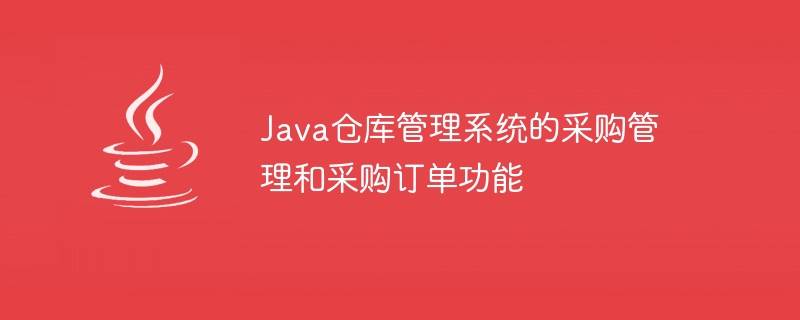Home >Java >javaTutorial >Purchasing management and purchase order functions of Java warehouse management system
Purchasing management and purchase order functions of Java warehouse management system
- WBOYWBOYWBOYWBOYWBOYWBOYWBOYWBOYWBOYWBOYWBOYWBOYWBOriginal
- 2023-09-25 20:28:411377browse

The procurement management and purchase order functions of the Java warehouse management system require specific code examples
With the rapid development of e-commerce and logistics industries, warehouse management systems have become increasingly important in enterprises. played a very important role. A good warehouse management system can improve an enterprise's logistics efficiency, reduce costs, and improve customer satisfaction. The procurement management and purchase order functions are key parts of the warehouse management system. This article will provide a code example of the procurement management and purchase order functions of a warehouse management system based on Java language to help readers better understand and practice this function.
In the procurement management function, we need to implement the following main functions:
- Supplier management: including the entry, modification, deletion and query of supplier information. Specific code examples are as follows:
public class Supplier {
private String supplierId;
private String supplierName;
//...
//getter and setter methods
}
public class SupplierManager {
private List<Supplier> supplierList;
public void addSupplier(Supplier supplier) {
//将供应商信息保存到数据库或者其他存储介质中
}
public void updateSupplier(Supplier supplier) {
//更新供应商信息
}
public void deleteSupplier(String supplierId) {
//删除指定供应商信息
}
public Supplier getSupplier(String supplierId) {
//根据供应商ID获取供应商信息
}
public List<Supplier> searchSuppliers(String keyword) {
//根据关键词搜索供应商信息
}
}- Purchase order management: including the generation, modification, deletion and query of purchase orders. The specific code examples are as follows:
public class PurchaseOrder {
private String orderId;
private String supplierId;
private Date orderDate;
//...
//getter and setter methods
}
public class PurchaseOrderManager {
private List<PurchaseOrder> purchaseOrderList;
public void createPurchaseOrder(String supplierId, Date orderDate) {
//生成采购订单
}
public void updatePurchaseOrder(String orderId, PurchaseOrder newOrder) {
//更新采购订单信息
}
public void deletePurchaseOrder(String orderId) {
//删除指定采购订单
}
public PurchaseOrder getPurchaseOrder(String orderId) {
//根据订单ID获取采购订单信息
}
public List<PurchaseOrder> searchPurchaseOrders(String keyword) {
//根据关键词搜索采购订单信息
}
}The above are simple code examples for procurement management and purchase order functions. I hope readers can understand and learn how to implement these functions in the Java warehouse management system through these examples. Of course, many other factors need to be considered in actual development, such as database design and connection, user interface design, etc. But the main purpose of this article is to provide a code example to help readers get started and understand the implementation of this feature.
Summary: The procurement management and purchase order functions of the warehouse management system are one of the key functions in the warehouse management system. This article provides a code example of the procurement management and purchase order functions of a warehouse management system based on Java language, hoping to help readers better understand and practice this function. Of course, in actual development, appropriate adjustments and improvements need to be made according to specific needs.
The above is the detailed content of Purchasing management and purchase order functions of Java warehouse management system. For more information, please follow other related articles on the PHP Chinese website!
Related articles
See more- How to understand polymorphism in java
- Using Java to develop a front-end and back-end separation architecture for a warehouse management system
- How to use Java to implement intelligent inspection and equipment remote monitoring functions of the warehouse management system
- How to use Java to implement artificial intelligence and machine learning technology in warehouse management systems
- Inventory turnover rate analysis and warehouse age control functions of Java warehouse management system

